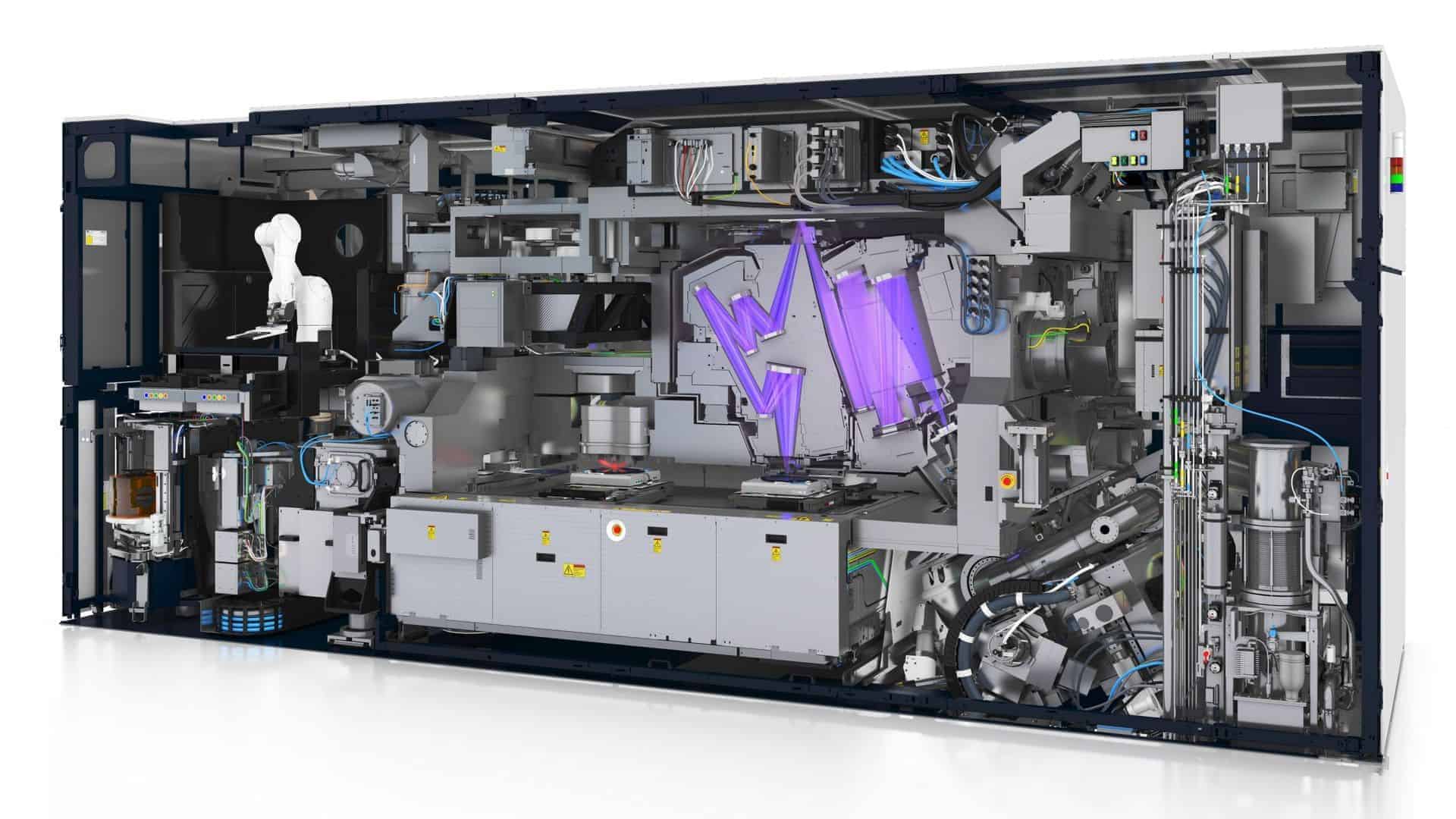EUV machines are at the heart of modern chip manufacturing. These cutting-edge tools use extreme ultraviolet lithography to create the tiniest features on semiconductors. EUV machines cost between $150 million to $380 million each.
ASML is the only company making these complex systems. They’ve sold about 140 EUV machines in the past decade. The price has risen as the technology has advanced.
The high cost reflects the incredible precision and engineering required. Each EUV machine contains 100,000 parts and 2 kilometers of wiring. The next generation, called High NA EUV, will cost even more. Intel has already ordered one for well over $380 million.
EUV Overview
EUV machines, or extreme ultraviolet lithography systems, are used to create microchips and can cost millions of dollars:
- Cost: EUV machines can cost hundreds of millions of dollars:
- EUV systems: A standard EUV system from ASML costs around $180 million, while High-NA EUV equipment costs around $380 million.
- Total cost: The total capital cost for a single EUV cluster is estimated to be around $150 million. This includes the cost of resist processing equipment and facilities hardware.
- Size: EUV machines are large, weighing 331,000 pounds and measuring 33 ft long, 17 ft wide, and 13 ft tall. They are shipped in 250 crates and require multiple transport aircrafts for delivery.
- Purpose: EUV machines are used in the high-volume manufacturing of advanced logic and memory chips. They print microchip features with a resolution that is unreachable with deep ultraviolet (DUV) lithography.
- How they work: EUV machines use extreme ultraviolet light to print a pattern onto a microchip wafer. The wafer is coated in a photosensitive material and exposed to light. The pattern is then used in further steps of the microchip design process.
| EUV Machine Type | Approximate Cost |
|---|---|
| Current EUV | $150-200 million |
| High NA EUV | $380+ million |

Image Credit: 2pem, CC BY-SA 3.0 https://creativecommons.org/licenses/by-sa/3.0, via Wikimedia Commons
EUV Machines: The Cutting Edge of Chip Manufacturing
EUV machines are revolutionizing the way we make computer chips. They use extreme ultraviolet light to create incredibly small and intricate patterns on silicon wafers, enabling the production of more powerful and efficient chips. Let’s explore what EUV machines are, how they work, and why they are so important.
What is an EUV Machine?
EUV stands for extreme ultraviolet lithography. It’s a highly advanced technology used in chip manufacturing to create the tiny circuits and components that power our electronic devices. EUV machines use a powerful laser to generate extreme ultraviolet light, which has a much shorter wavelength than traditional light sources used in lithography. This shorter wavelength allows for the creation of much smaller and more precise patterns on silicon wafers, leading to more powerful and efficient chips.
How EUV Lithography Works
EUV lithography is a complex process that involves several key steps:
- Light Source: A high-power laser is fired at tiny tin droplets to create plasma that emits EUV light.
- Mirrors: The EUV light is bounced off a series of highly reflective mirrors to focus and direct it.
- Mask: The patterned mask, containing the circuit design, is placed in the path of the EUV light.
- Wafer: The EUV light passes through the mask and projects the pattern onto a silicon wafer coated with a light-sensitive material.
- Development: The wafer is developed, removing the exposed areas and leaving behind the desired pattern.
Why EUV is Important
EUV technology is crucial for the continued advancement of chip technology. As transistors get smaller and more densely packed, traditional lithography methods struggle to create the intricate patterns required. EUV’s shorter wavelength allows for the creation of much finer patterns, enabling the production of more powerful, efficient, and complex chips. This translates to faster smartphones, more powerful computers, and more advanced artificial intelligence.
The High Cost of Cutting-Edge Chip Manufacturing
The Price Tag of EUV Machines
EUV machines are incredibly complex and expensive pieces of equipment. A single EUV machine can cost upwards of $150 – $380 million. This high cost is due to several factors, including the sophisticated technology involved, the precision engineering required, and the limited number of companies that manufacture these machines. The primary manufacturer of EUV machines is ASML, a Dutch company. Extreme Ultraviolet (EUV) lithography machines are essential for creating the most advanced computer chips. But they come with a hefty price tag. This is more than double the price of older lithography systems.
Why Are EUV Machines So Expensive?
EUV machines are incredibly complex. They use ultraviolet light with a wavelength of 13.5 nanometers to etch intricate patterns onto silicon wafers. This level of precision requires sophisticated engineering and expensive components.
Who Makes EUV Machines?
ASML, a Dutch company, is the sole manufacturer of EUV machines. Their monopoly on this technology contributes to the high cost.
Table: EUV Machine Costs
| Machine Model | Approximate Cost (USD) |
|---|---|
| ASML Twinscan NXE | $183 million |
| ASML Twinscan EXE | $380 million |
Impact on Chip Production
The high cost of EUV machines has several implications for the semiconductor industry. It limits the number of companies that can afford to invest in this technology, which could slow down the development of even more advanced chips. It also increases the overall cost of chip production, which could eventually lead to higher prices for consumers.
EUV Machine Cost Breakdown
| Component | Cost | Description |
|---|---|---|
| Lithography System: | $150 million – $300 million | This is the core of the EUV machine, responsible for projecting the light patterns onto the silicon wafer. The price varies depending on the specific model and its capabilities. |
| EUV Source: | $20 million – $50 million | This component generates the extreme ultraviolet light used in the lithography process. It is one of the most expensive parts of the machine. |
| Mask Aligner: | $10 million – $20 million | This component aligns the mask with the wafer to ensure precise patterning. |
| Stage & Wafer Handling: | $5 million – $10 million | This component moves the wafer into position under the EUV source and mask aligner. |
| Vacuum System: | $5 million – $10 million | This component maintains a vacuum environment inside the machine to prevent contamination. |
| Infrastructure: | $20 million – $50 million | This includes the cleanroom environment, power supply, and other infrastructure needed to operate the machine. |
| Installation & Maintenance: | $10 million – $20 million | This includes the cost of installing the machine and ongoing maintenance costs. |
| Total Cost: | $220 million – $500 million | This is the estimated total cost of an EUV machine, depending on the specific model and configuration. |
Additional Notes:
- The cost of EUV machines has been decreasing over time as technology advances and production becomes more efficient.
- However, EUV machines are still very expensive and represent a significant investment for chipmakers.
- The high cost of EUV machines is one of the factors that has led to the consolidation of the semiconductor industry, as only the largest chipmakers can afford to invest in the latest technology.
- The cost of EUV machines is expected to continue to decrease in the future, but they will likely remain expensive for the foreseeable future.
The Financial Aspect of EUV Lithography Systems
Purchase Price
EUV machines represent a significant investment in the semiconductor manufacturing process. In 2022, the cost for an individual EUV machine was estimated to be nearly $200 million. This estimate aligns with specific figures released by ASML, a leading manufacturer of these systems. For instance, ASML disclosed that four of its EUV systems had a combined value of approximately €595 million (around $703 million), putting the cost of each machine at about €148.75 million ($175.75 million). Another perspective puts the price of each EUV tool at around $120 million. The variation in these estimates reflects differences in machine specifications and the rapid evolution of technology in this sector.
Operational Costs
In addition to their hefty purchase price, EUV machines are incredibly expensive to operate. Their complexity and the precision required in their functioning contribute to the high operational costs. This aspect underscores the significant financial commitment companies must make when incorporating EUV technology into their production lines.
Physical and Operational Characteristics
EUV machines are not only costly but also massive and intricate. Weighing about 200 tons and the size of a city bus, these machines are composed of over 100,000 parts and often require transportation in upwards of 40 freight containers. These characteristics add to the logistical and operational challenges, further contributing to the overall cost.
Table: EUV Lithography vs. Traditional Lithography
| Feature | EUV Lithography | Traditional Lithography |
|---|---|---|
| Light Source | Laser-produced plasma | Mercury lamps |
| Wavelength | 13.5 nm | 193 nm |
| Resolution | Higher | Lower |
| Throughput | Lower | Higher |
| Cost | Higher | Lower |
Challenges and Future of EUV
While EUV lithography offers significant advantages, it also faces challenges. One major challenge is the lower throughput compared to traditional lithography methods. EUV machines are also more complex to operate and maintain. However, ongoing research and development are focused on improving EUV technology, increasing its throughput, and reducing its costs. EUV is expected to remain the dominant lithography technology for the foreseeable future, driving further advancements in chip manufacturing.
Semiconductor Industry Trends
The semiconductor industry is constantly evolving, driven by the demand for ever-more powerful and efficient chips. Here are some key trends shaping the industry:
- Miniaturization: The trend of shrinking transistors and increasing chip density continues, pushing the limits of lithography technology.
- 3D Stacking: To overcome the limitations of 2D scaling, manufacturers are exploring 3D stacking of chips, creating more powerful and compact devices.
- New Materials: Researchers are investigating new materials, such as graphene and carbon nanotubes, to replace silicon and further enhance chip performance.
- AI and Machine Learning: Artificial intelligence and machine learning are playing an increasingly important role in chip design and manufacturing, optimizing processes and accelerating innovation.
Understanding EUV Lithography Technology
EUV lithography represents a cutting-edge technique in semiconductor manufacturing. It uses extremely short wavelengths of light to create intricate patterns on silicon wafers.
Fundamentals of EUV Lithography
EUV lithography employs extreme ultraviolet light with a wavelength of 13.5 nanometers. This enables the creation of smaller and more densely packed transistors on chips. The process involves focusing EUV light onto a photoresist-coated wafer through a complex system of mirrors.
Key components of EUV systems include:
- Laser-produced plasma source
- Multilayer mirrors
- Photomask
- Projection optics
The short wavelength of EUV light allows for higher resolution and finer feature sizes compared to traditional lithography methods.
Advancements in EUV Systems
Recent advancements in EUV technology have focused on improving system performance and efficiency. High numerical aperture (High-NA) EUV systems offer enhanced resolution and productivity.
Key improvements include:
- Increased light source power
- Better resist materials
- Enhanced optical systems
These advancements enable the production of more advanced chips with smaller feature sizes. High-NA EUV systems can achieve resolutions down to 8 nanometers, pushing the boundaries of semiconductor manufacturing.
| EUV System Type | Resolution | Productivity |
|---|---|---|
| Standard EUV | 13 nm | Moderate |
| High-NA EUV | 8 nm | High |
EUV technology continues to evolve, supporting the development of increasingly powerful and efficient semiconductor devices.
EUV Machine Specifications and Performance
EUV machines represent cutting-edge technology in semiconductor manufacturing. These systems offer exceptional resolution and productivity for creating advanced logic and memory chips.
Key Features of Current EUV Machines
EUV lithography systems use extreme ultraviolet light to create intricate patterns on semiconductor substrates. They operate at a wavelength of 13.5 nm, enabling the production of smaller transistors and more densely packed chips.
Current EUV machines feature:
- Dual-stage design for improved throughput
- Laser-pulsed tin plasma as the EUV light source
- Advanced optics and mirrors for precise focusing
- Sophisticated alignment and overlay systems
The TWINSCAN EXE:5000 is a notable example of modern EUV technology. It provides 8 nm resolution and supports high-volume manufacturing of advanced chips.
Performance Metrics for High-NA EUV
High-NA (numerical aperture) EUV machines represent the next generation of lithography technology. They aim to extend Moore’s Law by enabling even smaller feature sizes and higher transistor densities.
Key performance metrics include:
| Metric | Current EUV | High-NA EUV |
|---|---|---|
| Resolution | 13 nm | 8 nm |
| Numerical Aperture | 0.33 | 0.55 |
| Wafer Throughput | Up to 160 wph | TBA |
High-NA EUV systems like the TWINSCAN EXE:5200 are expected to offer:
- Improved resolution for sub-3 nm nodes
- Enhanced overlay and focus control
- Increased productivity for high-volume manufacturing
These advancements come at a cost. High-NA EUV machines are priced at over $350 million each, reflecting their complexity and precision.
The Role of EUV Technology in Semiconductor Manufacturing
EUV lithography has revolutionized chipmaking. This advanced technology enables the production of smaller, more powerful microchips while increasing manufacturing efficiency.
EUV’s Impact on Chipmakers
EUV lithography systems have transformed semiconductor manufacturing. These tools allow chipmakers to create intricate patterns on silicon wafers with unprecedented precision. TSMC has doubled the productivity of its EUV systems since their introduction.
Key benefits of EUV for chipmakers:
- Smaller transistor sizes (down to 3nm and below)
- Higher chip density
- Improved energy efficiency
- Reduced manufacturing steps
Major players like Intel, TSMC, and Samsung have invested heavily in EUV technology. This investment helps them maintain a competitive edge in the rapidly evolving semiconductor industry.
The Shift from DUV to EUV Systems
The transition from deep ultraviolet (DUV) to EUV lithography marks a significant leap in chipmaking capabilities. EUV light has a wavelength of just 13.5 nanometers, much shorter than DUV.
Comparison of DUV and EUV:
| Feature | DUV | EUV |
|---|---|---|
| Wavelength | 193nm | 13.5nm |
| Minimum feature size | ~38nm | ~7nm |
| Complexity | Lower | Higher |
| Cost | Lower | Higher |
EUV enables the creation of chip features smaller than 7 nanometers. This advancement allows for more transistors on a single chip, boosting processing power and energy efficiency.
The shift to EUV has required significant investments from chipmakers. However, it’s essential for producing cutting-edge microchips used in smartphones, AI systems, and other advanced technologies.
Costs and Installation Considerations of EUV Machines
EUV lithography systems represent significant investments for semiconductor manufacturers. These machines come with hefty price tags and complex installation requirements.
Pricing of EUV Lithography Systems
EUV machines cost between $150 million to $400 million depending on the model. ASML’s Twinscan NXE series runs around $183 million. The newer High-NA EUV systems like the Twinscan EXE cost approximately $380 million.
Pricing factors include:
- Optics complexity
- Precision engineering
- Limited production volume
The table below compares costs of different EUV systems:
| EUV System | Approximate Cost |
|---|---|
| ASML Twinscan NXE | $183 million |
| ASML Twinscan EXE (High-NA) | $380 million |
Installation Process and Facility Requirements
Installing EUV machines demands specialized facilities. The process takes several months and requires:
- Cleanroom environments
- Stable power supply
- Vibration control systems
- Temperature and humidity regulation
Installation and maintenance costs range from $10-20 million. Cleanrooms must meet stringent particle control standards. Power systems need to handle the machine’s high energy consumption.
Robotics and AI assist in the precise positioning of components. The reticle and wafer stages require nanometer-level accuracy. IMEC and other research centers often test new EUV systems before wider deployment.
Frequently Asked Questions
EUV lithography machines are complex and expensive pieces of equipment. Their costs vary based on several factors, including model, capabilities, and additional components.
What is the price range for an ASML EUV lithography system?
ASML EUV lithography systems typically cost between $150 million to $400 million. The price depends on the specific model and its features. More advanced systems with higher precision and throughput tend to be at the upper end of this range.
How does the cost of DUV and EUV lithography machines compare?
EUV lithography machines are significantly more expensive than their DUV counterparts. While DUV systems cost a few million dollars, EUV machines can cost upwards of $150 million. This substantial price difference reflects the advanced technology and capabilities of EUV systems.
What factors contribute to the pricing of high-NA EUV scanners?
High-NA EUV scanners are even more costly than standard EUV machines. ASML’s High-NA Twinscan EXE systems cost around $380 million each. Their price is influenced by their advanced capabilities, increased complexity, and the research and development costs involved in their creation.
How much investment is required for an ASML EUV machine setup?
Setting up an ASML EUV machine requires a substantial investment beyond the cost of the machine itself. The setup includes the main lithography system, which can cost up to $400 million, and additional components like the EUV source, which may cost between $20 million to $50 million.
What are the financial considerations for acquiring an ASML lithography unit?
Companies considering an ASML lithography unit must factor in not only the initial purchase price but also ongoing operational costs. These may include maintenance, specialized training for operators, and potential upgrades. The high cost limits EUV adoption to advanced semiconductor manufacturers like TSMC, Samsung, and Intel.
Can you estimate the annual production cost for ASML EUV systems?
While exact annual production costs are not publicly available, it’s clear that manufacturing EUV systems is resource-intensive. ASML’s High-NA EUV machines weigh around 150,000 kilograms and require 250 engineers working for six months to assemble. This gives an indication of the significant production costs involved.
| Component | Cost Range |
|---|---|
| Main Lithography System | $150M – $400M |
| EUV Source | $20M – $50M |
| High-NA EUV Scanner | ~$380M |





